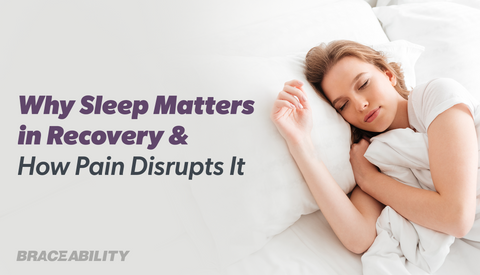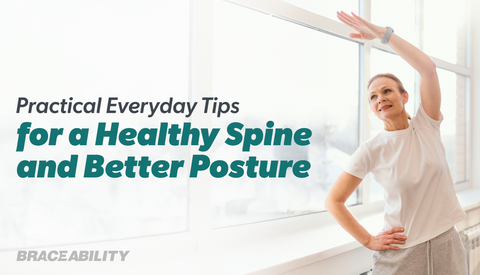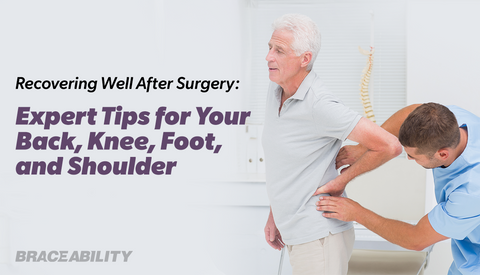Can Microbreaks Cure Lower Back and Hip Pain When Sitting?
Why Do I Have Lower Back/Hip Pain When Sitting?
Our bodies are not meant to hold any position for extended periods of time. Whether you sit, stand or walk all day, you are likely to develop some back, hip, leg or neck pain. It just so happens that many of us have desk jobs requiring long hours in a seated position.
Sure, after work you may spend some time at the gym, walking the dog, cooking, or wrestling with the kids. But unfortunately, you cannot “make up” for all that time on your butt, so your lower back is still likely to hurt when sitting. Plus, many of us wrap up a busy day sitting in front of the TV.
Your body is meant to move in a variety of ways throughout the day. Holding a static position for prolonged periods stresses your arms, shoulders, legs and especially the back.
Adding insult to injury, few office-dwellers maintain correct sitting posture throughout the day. We tend to slouch, which overstretches and strains the ligaments, discs, and other tissues of the spine, and generally throws the alignment of our back and hips out of whack. It’s no wonder so many complain about neck and lower back pain from sitting!
Knowing what causes lower back pain when sitting down is interesting and all, but what you’re really looking for is a relief, right?
Get Rid of Back Pain from Sitting Too Long with Microbreaks
If your job requires you to sit in front of a computer for hours on end, leaving you with stiffness and a backache when you finally stand up from your chair, maybe it’s time for a job switch. Kidding… sort of.
If that’s not an option, then you need to take action to get lasting relief. Life is too short to spend hours on end suffering from lower back pain while sitting.
Since the problem is your immobility, it seems logical that the key relieving lower back or hip pain due to sitting long hours lies in movement—not in finding the “best” office chair for lower back pain that makes it more comfortable to sit in a near-motionless state all day.
By movement, I am not talking about a trip to the bathroom or breakroom. While that’s better than nothing, you’ll have the best results if you work brief breaks into your workday where you up the ante a bit by doing some intentional, rhythmic movements that stretch, contract and work your muscles.
What Are Some Examples of Microbreak Exercises?
Getting up to do some light exercises that emphasize the range of motion of your joints can make a world of difference when it comes to eliminating low back pain when sitting.
Such exercises may bring to mind a warmup routine for a workout—think high-reps that get your heart rate up a bit and massage your tissues via movements that both contract and stretch your muscles.
Once again, variety is key. You should cycle through a number of different movements that work several areas of the body to get the most out of this practice to relieve back, hip, shoulder or leg pain when sitting.
Just a few examples of ones you can do with no special equipment include:
- Quick stair climbs
- Briskly walk, lunge or grapevine around the office or parking lot
- Air squats
- Seated trunk twists (there are quite a few variations of these)
- Arm hug exercise
- Twisting toe touches
- Leg swings
- Skaters exercise
- Sumo squat with shoulder lunge:
- Standing or seated cat/cow stretch
- Hip Raises
- Superman stretch
These are just a few examples to get you thinking. And with each exercise for easing low back pain from sitting, there are many modifications you can do to make them more or less challenging, such as adding in a weight, doing it with one leg, using a chair, etc.
You can do this in an AMRAP (as many reps as possible) format for your allotted break time or choose a series of exercises. Mix it up!
Benefits of Microbreaks
Besides the obvious benefits of easing lower back pain when sitting down, taking a quick break to move your body can also boost energy. That plus the absence of a distracting ache in your back can actually increase your focus and productivity. Plus this could save you some trips to the doctor, chiropractor, masseuse, etc.
This regular movement can also help with/prevent discomfort or stiffness in other areas, such as the knees, neck or shoulders. That’s another reason dynamic movements that use the whole body are a better option than doing a few static stretches.
How Often Should I Take Them?
Just how much of a commitment are we talking? In a perfect world, you could take two to five-minute break every half hour to get your blood pumping. But that is not realistic for most.
At a minimum, you should get up and do some mobility drills every hour. Whether that break is for two minutes or 10 minutes, just be sure you get up and move.
Many small breaks are better than one long one, as the problem is sitting still for hours at a time.
Fitting this into your schedule may take some sacrifice, both in terms of time and some funny looks from your coworkers. You may need to work through or shorten your lunch break and/or stay a bit later at work to make up for the little breaks throughout your day. Alternatively, some are able to keep working while on the move.
Keep reading for some tips that can help you stick to a microbreaking schedule.
5 Microbreaking Tips
One of the best things you can do to eliminate lower or upper back pain when sitting is to recognize the importance of taking these microbreaks and to make them an integral part of your day.
If you sit back and do nothing, thinking, “my back only hurts when I’m sitting,” or “it’s just a bit sore,” watch out. Minor discomfort now can evolve into severe pain down the road.
Following are few tips that can help you make microbreaks a habit:
- Use a timer (phones make this easy, or you can use an old-fashioned egg timer)
- Try a backache app.
- Grab a partner. Doing the exercises with someone else can hold you accountable and make you feel a bit less ridiculous all while building a closer relationship with someone.
- If stopping work is a concern, don’t stop. Use the time to check e-mails, read a report, make a phone call, etc.
- Wear clothes that are comfortable to move around in and keep a spare set of tennis shoes and socks on hand.
Other Steps for Alleviating Lower Back Pain When Sitting
Of course, microbreaking isn’t the only thing you can do to address lumbar pain after/while sitting.
You might try switching between standing and sitting throughout the day. The variance is a good way to prevent your sore back from getting worse.
On a similar note, switching what chair you sit in can also help limit back and hip pain when sitting down. Spending some time on an exercise ball or adding a destabilizing cushion to your seat can also keep your back engaged.
When you are seated, take care to sit up straight and use your best sitting posture. Doing so can avoid unnecessary strain on the back, shoulders, neck, etc. That means keeping your feet flat on the floor and using a cushion, pillow or towel to support the back where it does not come in contact with the back of the chair.
 You might also turn to a product for lower back pain relief, such as a compression back brace. Wearing it for a few hours a day may ease your discomfort stemming from all that time on your bottom. Lower-back belts can stimulate the soft tissues of the lower back via compression and gets your blood flowing. And good posture should carry throughout the day, whether you are running errands, driving, bending to lift something, texting or lounging on the couch at the end of the day. A posture brace can help you maintain healthy posture. You can also try our 21-day posture challenge to get you on the right track.
You might also turn to a product for lower back pain relief, such as a compression back brace. Wearing it for a few hours a day may ease your discomfort stemming from all that time on your bottom. Lower-back belts can stimulate the soft tissues of the lower back via compression and gets your blood flowing. And good posture should carry throughout the day, whether you are running errands, driving, bending to lift something, texting or lounging on the couch at the end of the day. A posture brace can help you maintain healthy posture. You can also try our 21-day posture challenge to get you on the right track.
Finally, if you sit all day at the office, you should do all that you can to limit inactivity during off hours. And if you do have to spend more time after work driving the kids to and from extracurricular activities or cheering them on from the stands, you can continue to work in some microbreaks.
Do what you can to incorporate movement into your day. Anything is better than nothing, and your body will thank you.











